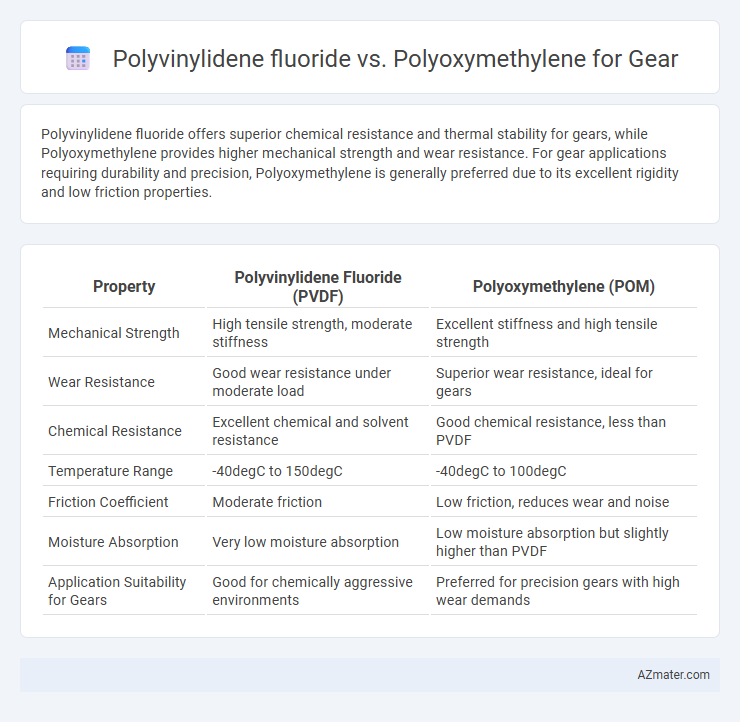Polyvinylidene fluoride offers superior chemical resistance and thermal stability for gears, while Polyoxymethylene provides higher mechanical strength and wear resistance. For gear applications requiring durability and precision, Polyoxymethylene is generally preferred due to its excellent rigidity and low friction properties.
Table of Comparison
| Property | Polyvinylidene Fluoride (PVDF) | Polyoxymethylene (POM) |
|---|---|---|
| Mechanical Strength | High tensile strength, moderate stiffness | Excellent stiffness and high tensile strength |
| Wear Resistance | Good wear resistance under moderate load | Superior wear resistance, ideal for gears |
| Chemical Resistance | Excellent chemical and solvent resistance | Good chemical resistance, less than PVDF |
| Temperature Range | -40degC to 150degC | -40degC to 100degC |
| Friction Coefficient | Moderate friction | Low friction, reduces wear and noise |
| Moisture Absorption | Very low moisture absorption | Low moisture absorption but slightly higher than PVDF |
| Application Suitability for Gears | Good for chemically aggressive environments | Preferred for precision gears with high wear demands |
Introduction to Engineering Plastics for Gears
Polyvinylidene fluoride (PVDF) and Polyoxymethylene (POM) are prominent engineering plastics utilized in gear manufacturing due to their distinct mechanical properties and chemical resistance. PVDF offers high corrosion resistance and excellent dimensional stability, making it suitable for gears operating in aggressive environments and requiring low wear rates. POM, known for its superior stiffness, low friction, and excellent fatigue resistance, is preferred for high-load gear applications where precision and durability are critical.
Overview of Polyvinylidene Fluoride (PVDF)
Polyvinylidene fluoride (PVDF) is a highly non-reactive and pure thermoplastic fluoropolymer known for its excellent chemical resistance and mechanical strength, making it suitable for gear applications in harsh environments. PVDF exhibits superior abrasion resistance and dimensional stability compared to Polyoxymethylene (POM), enhancing the durability and reliability of gears under high-load and high-temperature conditions. Its resistance to UV radiation and weathering also ensures long-lasting performance in outdoor or chemically aggressive settings.
Overview of Polyoxymethylene (POM)
Polyoxymethylene (POM), also known as acetal, is a high-performance engineering thermoplastic characterized by excellent mechanical strength, low friction, and outstanding dimensional stability, making it ideal for precision gears. Its high wear resistance and low moisture absorption help maintain gear performance in various environmental conditions. POM's rigidity and fatigue resistance provide durable gear operation, often preferred over polyvinylidene fluoride (PVDF) for applications requiring superior mechanical properties and dimensional accuracy.
Mechanical Properties Comparison
Polyvinylidene fluoride (PVDF) exhibits excellent chemical resistance, high tensile strength around 50 MPa, and moderate impact resistance ideal for gears operating in corrosive environments. Polyoxymethylene (POM) offers superior mechanical strength with tensile strength typically exceeding 70 MPa, higher stiffness, and low friction, making it preferred for high-load, precision gear applications. Comparison reveals POM's enhanced wear resistance and dimensional stability outperform PVDF in demanding mechanical gear functions despite PVDF's advantage in chemical durability.
Chemical Resistance and Environmental Suitability
Polyvinylidene fluoride (PVDF) exhibits superior chemical resistance compared to Polyoxymethylene (POM), with excellent tolerance to most acids, bases, and solvents, making it ideal for harsh chemical environments. PVDF maintains stability under UV exposure and high temperatures, enhancing its environmental suitability for outdoor and industrial applications. POM, while offering good mechanical strength and wear resistance, can degrade when exposed to strong chemicals and ultraviolet light, limiting its use in chemically aggressive or outdoor conditions.
Wear and Friction Performance in Gear Applications
Polyvinylidene fluoride (PVDF) demonstrates superior wear resistance and lower friction coefficients compared to polyoxymethylene (POM) in gear applications, enhancing gear longevity and efficiency. PVDF's chemical stability and self-lubricating properties contribute to reduced wear under high load and speed conditions, making it suitable for demanding mechanical environments. In contrast, POM, while offering good dimensional stability and machinability, tends to exhibit higher friction and wear rates, limiting its performance in high-stress gear systems.
Dimensional Stability Under Operational Loads
Polyvinylidene fluoride (PVDF) exhibits superior dimensional stability under operational loads compared to Polyoxymethylene (POM), maintaining its structural integrity in high-stress gear applications. PVDF's high resistance to creep and low thermal expansion contribute to minimal deformation during prolonged mechanical stress, ensuring precise gear performance. In contrast, POM may experience slight dimensional changes due to load-induced stress and temperature variations, potentially affecting gear accuracy and lifespan.
Processability and Manufacturing Considerations
Polyvinylidene fluoride (PVDF) offers superior chemical resistance and excellent dimensional stability, making it ideal for precision gear manufacturing requiring high corrosion resistance; its processability includes easier injection molding with consistent melt flow properties. Polyoxymethylene (POM), known for its high stiffness and low friction, excels in machining and molding for durable mechanical gears but demands tighter process controls due to moisture sensitivity and potential thermal degradation during manufacturing. Choosing between PVDF and POM for gears depends heavily on the specific application environment, with PVDF favored in chemically aggressive settings and POM preferred for high-load mechanical performance and cost-effective manufacturing processes.
Cost Analysis for PVDF vs POM Gears
Polyvinylidene fluoride (PVDF) gears generally have a higher initial material cost compared to Polyoxymethylene (POM) gears due to PVDF's enhanced chemical resistance and durability properties. POM gears are more economical for mass production, offering lower raw material costs and easier machinability, which reduces manufacturing expenses. When evaluating long-term cost efficiency, PVDF gears may provide superior performance in harsh chemical environments, potentially lowering maintenance and replacement costs despite higher upfront investment.
Application Scenarios and Industry Recommendations
Polyvinylidene fluoride (PVDF) excels in chemical resistance and high-temperature stability, making it ideal for gears in corrosive environments and industries such as chemical processing and pharmaceuticals. Polyoxymethylene (POM), known for its high stiffness, low friction, and excellent wear resistance, suits precision gear applications in automotive, electronics, and consumer goods manufacturing. Industry recommendations suggest using PVDF gears where exposure to aggressive chemicals and thermal stability are critical, while POM gears are preferred for high-load, mechanical wear, and dimensional stability in general engineering contexts.

Infographic: Polyvinylidene fluoride vs Polyoxymethylene for Gear
 azmater.com
azmater.com